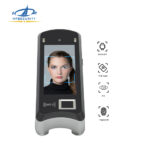What Is Facial Biometrics?
How Facial Biometrics Works
Facial biometrics systems work through a series of sophisticated steps to capture, analyze, and verify an individual’s identity. Each step leverages advanced AI algorithms, 3D imaging, and biometric verification techniques to ensure high accuracy and security.
1. Face Detection and Localization
The first step in facial biometrics authentication is detecting and locating a human face within an image or video stream. Advanced face detection algorithms powered by AI and deep learning identify facial regions even under challenging conditions such as varying lighting, angles, or partial occlusions.
2. Feature Extraction and Mapping
Once the face is detected, the system extracts unique facial features to create a digital template. This includes distances between key landmarks such as the eyes, nose, mouth, jawline, and cheekbones. Modern systems may use 3D facial scanning or infrared imaging to enhance accuracy.
3. Template Matching and Biometric Verification
After feature extraction, the system compares the captured facial template against a stored biometric database. This face matching process uses advanced algorithms to measure similarity scores and verify the identity of the individual.
4. Liveness Detection and Fraud Prevention
To prevent spoofing using photographs, videos, or masks, modern facial biometrics systems incorporate liveness detection. This ensures that the system only authenticates live individuals. Techniques include infrared vein detection, 3D depth sensing, blink detection, and AI-based behavioral analysis.
Key Advantages of Facial Biometrics
Facial biometrics offers several benefits over traditional authentication methods and other biometric technologies:
High Security: Each face has unique features, making it difficult to forge or replicate.
Contactless Operation: Ideal for hygiene-sensitive environments, especially post-pandemic.
Fast and Efficient: Recognition and authentication can occur in milliseconds.
Scalable: Can be integrated into various devices, including mobile phones, turnstiles, attendance machines, and smart access control systems.
Versatile Applications: Useful in corporate offices, banks, airports, healthcare facilities, schools, and public security systems.
Applications of Facial Biometrics
Facial biometrics has broad applications across multiple industries:
Access Control and Security: Used in corporate buildings, smart offices, and high-security areas to allow authorized personnel while preventing unauthorized access.
Time and Attendance Systems: Companies deploy facial recognition terminals to monitor employee attendance, reducing buddy-punching and enhancing workforce management.
Banking and Finance: Facial biometrics ensures secure authentication for online banking, ATMs, and mobile payment systems.
Airport and Border Control: Airports use face recognition to speed up check-in, immigration clearance, and boarding processes.
Healthcare: Hospitals use facial biometrics for secure patient identification and access to sensitive areas.
Smart Cities and IoT: Facial biometrics supports smart city initiatives, surveillance systems, and connected devices.
Future Trends in Facial Biometrics
The field of facial biometrics is evolving rapidly with technological advancements:
AI and Deep Learning: Improved accuracy through AI-driven facial recognition algorithms.
3D Facial Recognition: Captures depth information for higher security and resistance to spoofing.
Integration with Multimodal Biometric Systems: Combining facial biometrics with fingerprint, iris, or palm vein recognition for even greater security.
Privacy and Compliance Innovations: New systems aim to comply with GDPR and other privacy regulations while maintaining high security standards.
Conclusion
Facial biometrics is a cutting-edge biometric technology that provides secure, fast, and contactless identity verification. Its applications span access control, attendance management, banking security, airport operations, and more. As AI, 3D imaging, and liveness detection technologies continue to advance, facial biometrics is expected to play an increasingly critical role in modern security systems and smart technology solutions.
For organizations seeking efficient and reliable biometric authentication, facial biometrics offers a versatile and future-ready solution.
Contactez-nous
We would love to speak with you.
Feel free to reach out using the below details.





